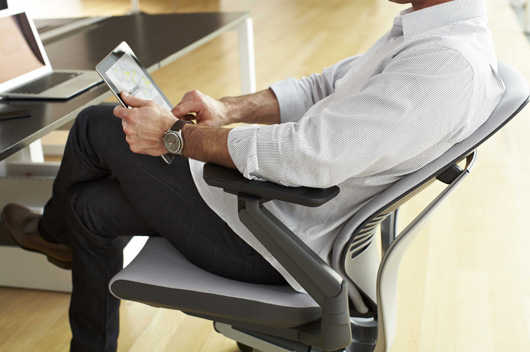Steelcase launches Gesture, designed in response to the new changing postures in the workplace

Steelcase launches Gesture, a new sitting experience, designed in response to the company's latest research about changing postures in the workplace. The global study reveals how new technologies have led to nine new postures — not supported by current office chairs — which frequently cause pain and long-term injuries, disrupting concentration and creativity. The Gesture chair was inspired by studying the movement of the human body and created for the ways people work today.
“We love our technology - it's become a ubiquitous extension of ourselves,” states James Ludwig, vice president of global design for Steelcase. “The user interface is intuitive and responds to various gestures. But what about gesture recognition for the human body? The way technology impacts our bodies as we work has been largely ignored.”
Steelcase conducted a global study in 11 countries, observing over 2000 people in a wide range of environments and postures. Company researchers discovered nine new postures that were a result of new technologies and new workplace behaviors. If not adequately addressed, these postures can cause pain, discomfort and long-term injuries for workers.
“Tablets were introduced just three years ago. But many people are using chairs that were designed well before these new devices became pervasive at work. Back then, chairs were created to help people hold one pose in front of a computer all day. Now we know that people need to move and change positions regularly, especially as they engage with new technologies. We observed people in pain — they need a sitting experience designed for the ways we work today,” continued Ludwig.
Video presentation Gesture chair by James Ludwig, vice president of global design for Steelcase
Gesture: A New Sitting Experience
Steelcase researchers studied how the physiology of work has changed, how the human body interacts with new technologies and how it transitions as people shift from one device to another. Researchers noted a more extreme range of human sizes around the world, which impacts postures. The company also studied the changing sociology of work and how people rapidly shift between individual, focused tasks and creative collaboration. Each new activity caused people to change postures. Based on this research, Steelcase designed the Gesture chair's three key interfaces - the core interface, upper limb interface and seat interface — to support new postures driven by new technology and more casual behaviors in the workplace.

For example, Gesture encourages motion rather than forcing the body to hold a single posture. The upper limb interface allows people to draw closer to a work surface to avoid hunching over a screen and easily move close to the body to support texting postures. Unlike conventional chairs, the Gesture chair's core interface hugs the lower back when people recline to scroll on a tablet screen. The seat interface adjusts rapidly to help users avoid perching on the edge of their chair. Gesture embraces a broad range of body sizes and easily adapts to meet the needs of each individual user, which is critical in an increasingly global business environment that has to support a more diverse workers than ever before. The Gesture chair is a system of interconnected parts - inspired by the human body - designed to support every movement.
“Today's workers are driven by their vision - small technologies have a gravitational force to pull the body down,” explained Carol Stuart Buttle, CPE, Principal at Stuart-Buttle Ergonomics. “If the chair doesn’t move with the user, people slouch to make up for it, or flop on the desk to overcompensate for what is uncomfortable. Workers today are moving from bad posture, to bad posture, to bad posture. Gesture helps you be where you need to be - it helps workers find support in smarter ways so they can use their devices in safer ways.”
Source: Steelcase
Read more news related Steelcase published at Infurma
Visit the AF Steelcase website
News Infurma:
Online Magazine of the International Habitat Portal. Design, Contract, Interior Design, Furniture, Lighting and Decoration
